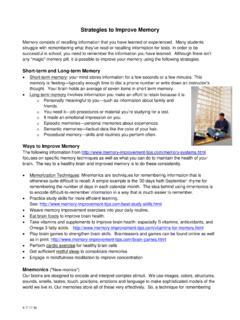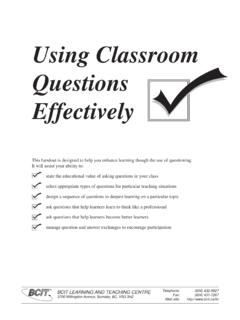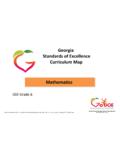Transcription of REVIEW SHEETS BASIC MATHEMATICS MATH 010
1 11/2015 REVIEW SHEETS BASIC MATHEMATICS MATH 010 A Summary of Concepts Needed to be Successful in MATHEMATICS The following SHEETS list the key concepts that are taught in the specified math course. The SHEETS present concepts in the order they are taught and give examples of their use. WHY THESE SHEETS ARE USEFUL To help refresh your memory on old math skills you may have forgotten. To prepare for math placement test. To help you decide which math course is best for you. HOW TO USE THESE SHEETS Students who successfully REVIEW spend from four to five hours on this material. We recommend that you cover up the solutions to the examples and try working the problems one by one. Then check your work by looking at the solution steps and the answer. Note: Calculators will only pop up on the test for selected problems, so you should practice without using one. KEEP IN MIND These SHEETS are not intended to be a short course. You should use them simply to help you determine at what skill level in math you should begin study.
2 For many people, the key to success and enjoyment of learning math is in getting started at the right place. You will most likely be more satisfied and comfortable if you start onto the path of math and science by selecting the appropriate beginning stepping stone. I. Whole number concepts You should have the following skills with whole numbers: Recognize place value for each place. Name numbers correctly with words. Write numbers correctly given the word names. Add, subtract, multiply and divide. Round numbers to any given place. Estimate sums, differences , products and quotients. 11/2015 Solve application problems using whole numbers. Correctly apply the order of operations. Express numbers using exponents. Distinguish between prime and composite numbers. Give the prime factorization of numbers. Find the Lowest Common Multiple of two numbers. 1. What place value does 3 have in 4,235,100? 2. Which digit is in the thousands place in 4,968,123? 3.
3 Write correctly in words: a. 305 b. 10,660 4. 46 + 729 + 1025 + 47 = 5. 96 + 321 + 21 = 6. 423 69 = 7. 982 793 = 8. 145 x 36 = 9. 21 14 = 10. 396 23 = 11. 5422 12. Round 799 to the nearest ten 13. Round 92,449 to the nearest thousand 14. Round 4,868 to the nearest hundred 15. Round 123 to the nearest hundred 16. Estimate the sum of 38 + 99 + 21 + 14 17. Estimate the difference of 621 - 267 by rounding to the nearest ten. by rounding to the nearest hundred. 18. Estimate the quotient of 48 8 19. Estimate the product of 67 x 23 by rounding to the nearest ten. by rounding to the nearest ten. 20. Thirty identical chairs cost $1680. What is the cost of one chair? 21. Jose read 39 books in 1994, 27 books in 1995, and 35 books in 1996. How many books did he read over the 3 years? 22. Bart gives the cashier three $50 bills to pay for a purchase of $123.
4 How much change should he get back? 23. What is the number of square yards in a field that measures 30 yds. by 41 yds. ? 11/2015 24. Rewrite using exponents a. 9 x 9 b. 5 x 5 x 5 25. Rewrite without exponents a. 45 b. 73 26. 12 4 x 3 = 27. 3 x 3 3 = 28. 9 6 29. 14 + 7 x 2 = 30. 3 x (6 + 2) 3 + 4 2 = 31. 5 x {3 x [9 (4 + 1)]} + 20 4 x 2 = 32. Find the prime factorization of each number: a. 12 b. 100 b. 81 d. 105 33. Find the Least Common Multiple of each pair of numbers: a. 6 and 12 b. 6 and 7 c. 12 and 18 d. 15 and 30 e. 14 and 49 II. Fractions You should have the following skills with fractions: Calculate what fraction of a set of assorted objects are shaded. Convert fractions to equivalent fractions. Reduce fractions. Multiply fractions and simplify. Find reciprocals. Divide fractions and simplify.
5 Find the lowest common denominator (LCD) of two fractions. Add fractions and simplify. Subtract fractions and simplify. 34. What fraction of the rectangles are shaded? 35. What fraction of the objects are geometric shapes? ! ? ; 36. What fraction of the objects are numbers? 1, 2, * , , 4, 9, 11/2015 37. Which fraction is equivalent to ? 38. Which fraction is equivalent to ? 39. Reduce each fraction to lowest terms: a. b. c. 40. Multiply each pair of fractions and simplify (reduce) the result: a. b. c. d. 41. Find the reciprocal of each number: a. b. c. 6 42. Divide and simplify the results: a. b. c. 43. Find the lowest common denominator (LCD) of each set of fractions: a. , b. , c. , , d. , e.
6 , f. , 11/2015 44. Add and simplify: a. + b. + c. + 45. Subtract and simplify: a. - b. - c. - d. - III. Mixed numbers You should have the following skills with mixed numbers: Change a mixed number to an improper fraction. Change an improper fraction to a mixed number. Multiply and simplify. Divide and simplify. Add and simplify. Subtract and simplify. Solve application problems involving fractions and mixed numbers. 46. Change to improper fractions: a. 2 b. 3 c. 7 47. Change to mixed numbers: a. b. c. d. 48. Multiply and simplify: a. 1 2 b. 2 11/2015 c. 1 1 49. Divide and simplify: a. 6 1 b. 2 1 c. 4 1 50. Add and simplify: a. 3 + 2 b. 1 + 2 c. 3 + 5 51. Subtract and simplify: a.
7 3 - 1 b. 5 - 2 c. 9 - 3 52. Solve each application problem: a. A recipe calls for 5 cups of flour. How many cups of flour are needed for of the recipe? b. A bamboo plant grew inch Monday, inch Tuesday, and inch Wednesday. How many inches did the bamboo grow in the 3 days? c. A share of stock XYZ went from $40 to $42 . What was the dollar gain for the stock XYZ? d. How many cubic yards of cement must be ordered to pour a sidewalk 30 yd by 1 yd by yd? 11/2015 IV. Decimals You should have the following skills with decimals: Recognize the value of each place in the number. Be able to name decimal numbers accurately. Round decimals accurately. Add, subtract, multiply and divide (to 3 decimal places). Solve application problems involving decimals. 53. What place value does 3 have in 54. What digit is in the ten-thousandths place in 55. Write the word name for each decimal number: a.
8 B. c. 56. Write the decimal number for each word name: a. four thousand and three hundredths b. seventy-eight hundred-thousandths c. one hundred two and two tenths 57. Round each number to the indicated place: a. to nearest hundredth b. to nearest tenth c. to nearest thousandth d. to nearest hundredth 58. + + = 59. = 60. x = 61. 3 = 62. = 63. If two dresses that are the same price cost $ total, how much does one dress cost? 64. If 4 shirts cost $ , 3 coats costs $ , and 4 pairs of slacks cost $ , what is the total for all the clothing? 65. If a steel beam cm long is to be cut into pieces that are cm in length, how many pieces will there be? 66. If each cookie at a bake sale costs $ , how much does a dozen cost? 11/2015 Math 010 REVIEW Answers 1. ten thousands 4,235,100 4 = millions 2 = hundred thousands 3 = ten thousands 5 = thousands 1 = hundreds 0 = tens 0 = ones 2.
9 8 3a. three hundred five 3b. ten thousand, six hundred sixty 4. 1,847 46 5. 438 729 1025 + 47 1,847 6. 354 423 7. 189 - 69 354 8. 5,220 145 9. 294 (A dot also means multiply) x 36 870 435 5,220 17 R 5 10. 396 23 = 23 ) 396 11. 318 r 16 - 23 166 - 161 5 12. 800 13. 92,000 14. 4,900 15. 100 16. 40 + 100 + 20 + 10 = 170 17. 600 - 300= 300 18. 50 10 = 5 19. 70 x 20 = 1400 11/2015 20. $1680 30 = $56 21. 101 books 22. 3 x $50 = $150; $150 $123 = $27 change 23.
10 30 yd x 41 yd= 1230 sq yd Exponents: They represent repeated multiplication. 3 x 3 x 3 x 3 = 34 The 3 is the base, the 4 is the exponent and tells how many factors of the base there are. 24a. 92 24b. 53 25a. 4 x 4 x 4 x 4 x 4 25b. 7 x 7 x 7 Order of operations: Parentheses { [ ( ) ] } Work from the inside to outside. Exponents and radicals Multiplications and division as they occur left to right Additions and subtractions as they occur left to right 26. 12 4 x 3 = 27. 3 x 3 3 = 3 x 3 = 9 3 = 9 3 28. 9 6 2 = 29. 14 + 7 x 2 = 9 - 3 = 14 + 14 = 6 28 30. 3 x (6 + 2) 3 + 4 2 = 31. 5 x 3 x [9 (4 + 1)]} + 20 4 x 2 = 3 x 8 - 3 + 4 2 = 5 x {3 x [9 - 5]} + 20 4 x 2 = 24 - 3 + 4 2 = 5 x {3 x 4} + 20 4 x 2 = 24 - 3 + 2 = 5 x 12 + 20 4 x 2 = 21 + 2 = 60 + 5 x 2 = 23 60 + 10 = 70 Prime and composite numbers: Prime numbers (such as 2, 3, 5, and 7) have only themselves and 1 as factors.










